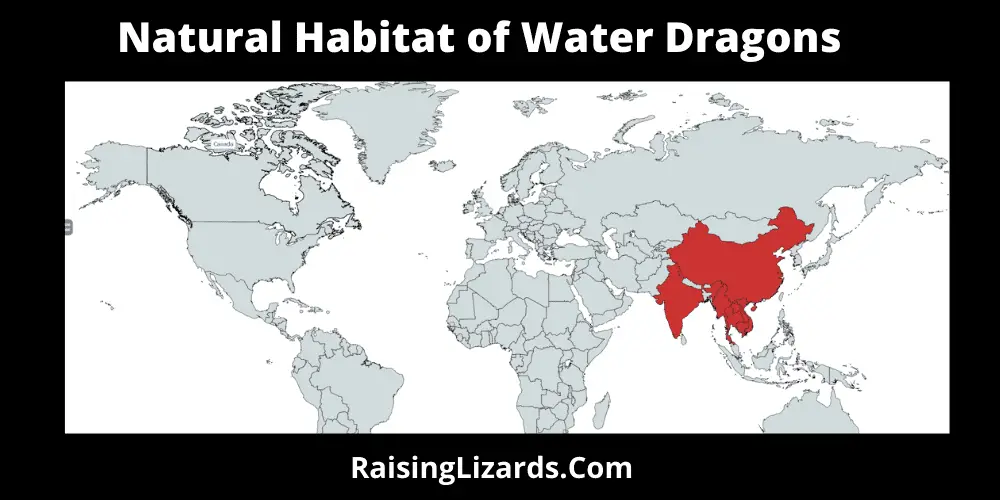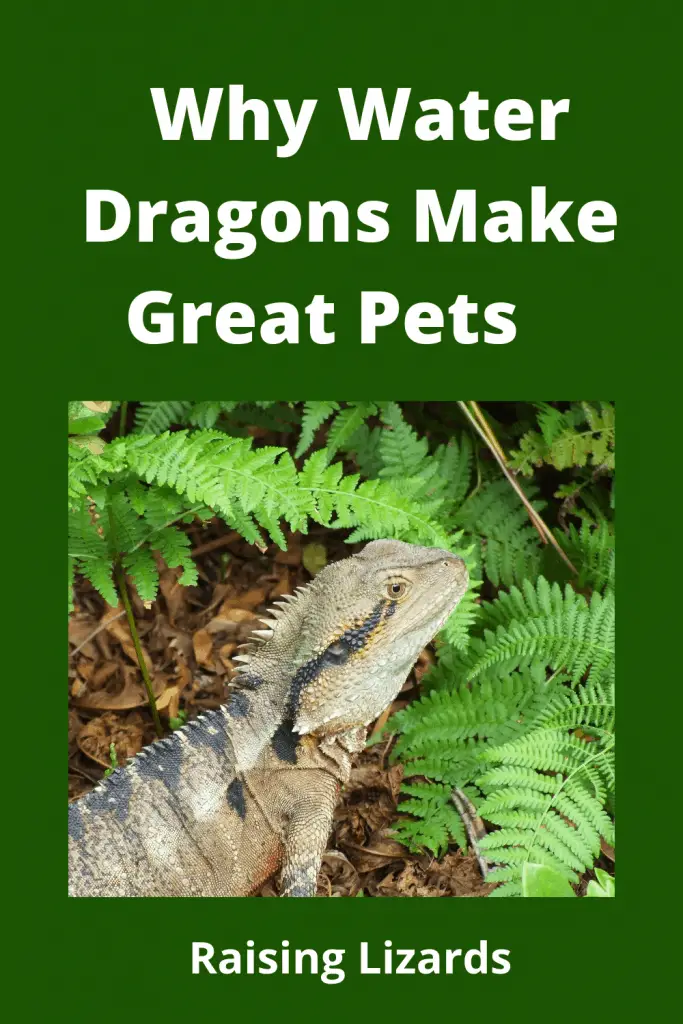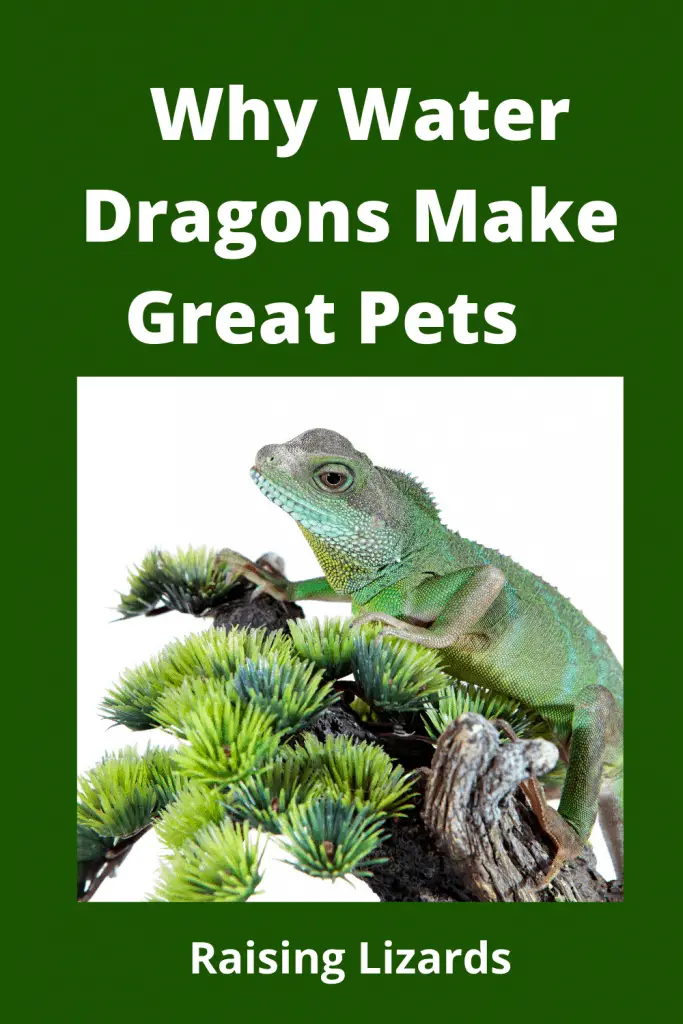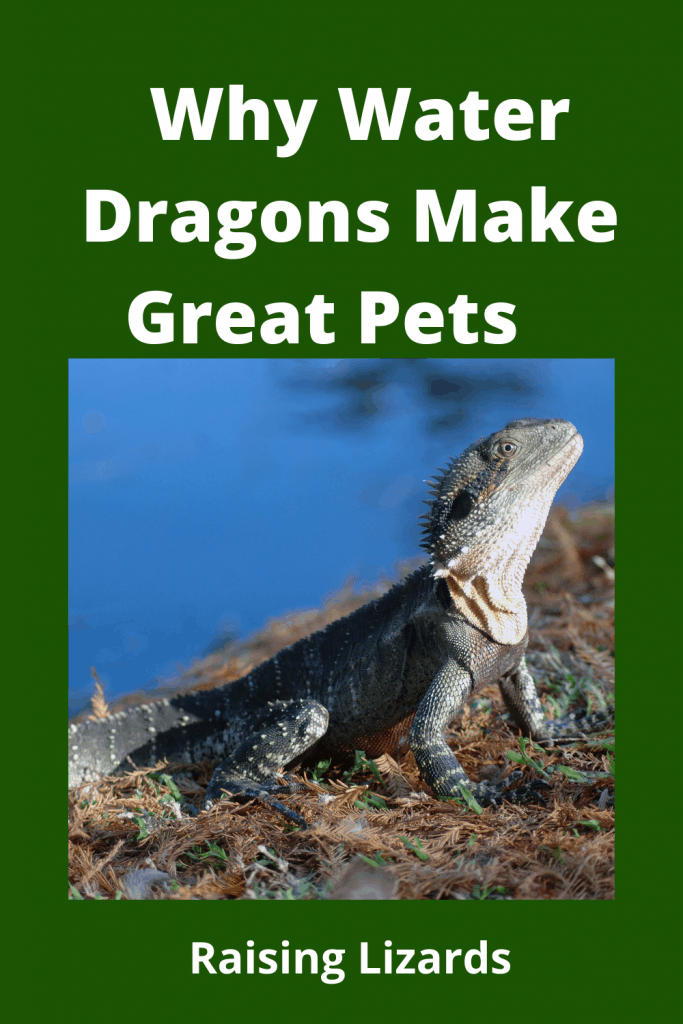General Reasons Water Dragons Make Good Pets –
- Beautiful Colors
- Long Lifespans 10 – 15 Yrs
- Average Size of Males – 36″ / Females 24″
- Very Hearty
- Comparing Lizards – Easy to Care for
- Take a Variety in Diet
- Can Be Handled Carefully
- Friendly to Owners
Why Water Dragons Make Great Pets. Water dragons are a neat looking reptile that can make great pets in the right environment. These lizards are smart, fairly low-maintenance, and fun to handle! But it is crucial to know what their care requirements are before you rush out and get one. There are a few things you will need to know about this species if you want to keep them happy and healthy. In this guide, we take a deep look at everything you need to know about water dragon care. You will learn how to set up their enclosure, what to feed them, and plenty of other useful facts!
Species Summary / Why Water Dragons Make Great Pets
The Water dragons (Intellagama lesueurii) is a reptile that easily adapts to the presence of humans. Docile and easy to tame, these lizards make excellent pets for even novice enthusiasts. As their name would suggest, the Water dragons are native to Southern China

. There, you will often see them living amongst humans in parks or gardens. In more rural areas, the lizards inhabit forests around bodies of water. This species is extremely adaptable and can cash in on the many different environments to feel safe. They can live in tall trees or rest at the bottom of a riverbed to escape predators! In captivity, however, these lizards are just fine within the safety of a well-maintained enclosure.
Appearance & Colours
Water dragons have many physical features that reflect their lifestyle. Water dragon uses its long and powerful legs for climbing. Each leg has lengthy toes and sharp claws as well to grab onto trees and other structures. For swimming, the water dragon uses its muscular tail.
Making up about two-thirds of its entire length, the tail is one of the lizard’s most important features. It is laterally compressed, which helps the lizard zip through the water with ease. This species is also defined by its prominent nuchal and vertebral crests.
The nuchal crests start at the bottom of the top. They are tall and spiky but gradually get smaller near the tail. There are a few various subspecies that are quite similar overall. However, subtle colour variations make the two subspecies easy to distinguish.

All Water dragons feature greyish brown coloration. Typically, the base colour is accompanied by white and black markings around the face. The Intellagama lesueurii subspecies of water dragon has hues of yellow & red colour on the throat. They are also sporting a black band behind the eye. Meanwhile, the Intellagama lesueurii has dark bands on each side of the throat. You might also see blotches of yellow, orange, and blue.
Lifespan
The average water dragon’s lifespan is between 10 and 15 years. But obviously, there is never a guarantee when it comes to life expectancy. Like any other captive reptile, the lifespan of this species depends on the standard of care you provide. If kept in dirty conditions or fed an inadequate diet, your lizard could suffer from disease and die prematurely.
Average Size
The average size of Water dragons is up to 36 inches in length for males, and 24 inches for females. This is due to long tail of water dragon, which makes up two-thirds of their body length. The factors that influence their size most are breeding practices, genetics, and early care. Make sure to do your homework before purchasing water dragon, if you want your them to be big and strong,
Water Dragons Care
Water dragons care is a relatively easy task. Due to their hardiness and adaptableness, these reptiles usually have not any problem living long and happy lives as pets. That said, you still must follow some established guidelines. In the wild, these lizards live in a wide range of environments. It is your job as an owner to replicate those environments as closely as possible while providing the lizard with all the essentials.
Enclosure Size
First you need find an appropriately sized enclosure for water dragons. These lizards do best in vivariums with a swinging front door and adjustable air vents. Opaque sides are best. A fully transparent enclosure could make the lizard feel open to threats. You will also need to make sure the size of the enclosure is rather large. At the very least, we recommend keeping a single Water dragon in an enclosure that is 48 inches long, 24 inches deep, and about 36 inches wide. If possible, raise the length of the enclosure to about 60 inches.

Habitat Setup
Here is where you can get creative. These lizards often inhabit forests that are on the brink of rivers or streams. Thus, they are used to vegetation and lots of humidity. Start with a moisture-absorbing substrate at the bottom. You can use coarse wood chips or a fertilizer-free mix of soil and peat moss.
Both substrate options will hold onto moisture to keep humidity levels high. You can even use paper towels if you’re on a budget! Next, you will need to provide some climbing surfaces. Use large tree branches, chunks of cork wood, and climbing branches. Arrange them delicately so that they are not touching.
Create a network of paths so that your lizard has plenty of options to explore. Once that has done, you will need to create some shelter. You can do this by using a reptile hide box. However, many owners prefer to keep things natural in the habitat by utilizing plants as well.
Both live and artificial plants work well. Live plants are great for humidity, but plastic ones are better for maintenance and overall cleanliness.
You should also add some resting rocks made of natural stone. Materials like slate are perfect because they keep the heat for a little belly warmth.
Pinterest Enclosure Ideas

Temperature & Lighting
Water dragons are cold-blooded animals and need supplemental heat for correct digestion. They like 84-88F during the day and temperatures within the high 70’s in the dark. Reptiles cannot digest its food if they are cold and is more likely to get ill. Place a quality thermometer within the cage at the extent the water dragon spends most of its time, so you can monitor the temperature. Placing couple of thermometers in different areas of the vivarium is optimum.
Primary heat source: A primary heat source is important to stay the temperature of the whole cage within the right range. A series of incandescent lights over the cage is one among the simplest heat sources. At night, these lights should turn off and another heat source could also be needed counting on the ambient temperature. For larger enclosures, an area heater or separate room thermostat are often wont to keep the space at the acceptable temperature. Fire alarms should also be placed in rooms.
Secondary heat source: A secondary heat source creates more heat in specific areas of the cage to supply a gradient. For good supply this gradient, the secondary heat source needs to cover only 25-30% of the surface of the enclosure. For adults, the secondary heat source might be a 30-75-watt incandescent bulb during a ceramic base, securely mounted where the animal cannot touch it. There also are special ‘basking lights’ available. sort of light should shine down on a specific basking area from outside the cage. The temperature under the sunshine within the area during which the Thai water dragon would be basking should be 90-95F.

Light
Visible white light: Additionally, to heat, incandescent bulbs also provide visible white light. A mixture of fluorescent and incandescent lighting fixtures provides light to all or any areas of the enclosure. Water dragons are diurnal, needing a particular photoperiod simulating day and night.
Ultraviolet light: Water dragons must have access to natural sunlight. This is often because they have a particular spectrum of ultraviolet (UV) light called UVB. UVB is important for the water dragon to form vitamin D.
No artificial light is nearly as good as sun in providing UVB, so when the surface temperature on a sunny day is over 70F, place your water dragon outside during a secure screen or wire cage with a locking door. Provide some shade and a topographic point within the enclosure. UV rays don’t penetrate pane, so water dragons placed near a sunny window won’t receive UV light.
If a water dragon doesn’t have access to bright sunlight, special lights are wont to provide the UVB light. These black lights for reptiles are not the black light tubes used for lighting fluorescent minerals, posters, and psychedelic paraphernalia (often called BLB lights).
Fish/aquarium and plant ‘grow’ lights, either incandescent or fluorescent, don’t produce UVB. Lights producing only UVB, and lights that produce a mixture of UVB and white lights are available. Zoo Med’s reptile or iguana lights, and Ducrest’s Vita-Lite are two good products. These UVB light sources should get replaced every six months. There are certain mercury halide lamps which will even be wont to provide UVB also as heat. These are costlier but longer lasting and will get replaced every two years.
Remember that UV light cannot penetrate glass, so when overhead UVB light sources are used, the highest of the enclosure must be a wire mesh that’s not too fine.
It’s recommended that a fluorescent UVB light should be but 18 inches from where the water dragon spends most of its time; 10-12 inches is perfect. Mercury halide sources are often up to three feet away. The areas illuminated by the incandescent basking light and therefore the UV light should overlap.
Humidity
High humidity levels are a must with Water dragons. This species will always need around 70 percent humidity levels. They can tolerate levels as low as 40 percent, but they might start to experience health issues outside of that range. To maintain this, you will have to mist the environment regularly.
You can use an automatic dripper also if you favour. Invest during a reliable hygrometer to check humidity levels regularly. If you would like to boost the humidity, simply mist the substrate and plants. To lower it, open some vents to let the moisture evaporate.
Water
Water dragons like to spend time within the water. When escaping predators in the wild, they can dart through the water and hold their breath for up to 90 minutes! Providing a sizable swimmable space in your enclosure probably is not viable, but you need to add a large container that they can get into.
The container for the water dragon should not be smaller than about three-quarters of the length of your water dragon. It should be deep for full submersion. It is very important to change this water regularly. Your lizard will likely defecate in it, so you must stay on top of cleanliness to keep bacteria under control.
Water Dragons Diet
In the wild, Water dragons are very opportunistic eaters with a flexible diet. Fortunately, you do not have to go to those extremes to keep your pet healthy in captivity. A good diet will mainly consist of insects. Brown crickets, black crickets, and locusts are good diet staples. For the occasional snack, you’ll provide mealworms, beetle grubs, cockroaches, and waxworms.
These goods are high in fat, so do not feed them to your lizard too often. Also, confirm to gut-load insects before providing them as food. For plant-based foods, you’ll offer some dandelion greens, clover leaves, green beans, yellow squash, and sweet potato. Water dragons are split when it comes to fruit. They may enjoy sweets like bananas and strawberries, but some will not eat them at all. For improved health, you can provide supplements. Just dip the foods in the powdered supplement. Many owners will alternate between a calcium supplement and a multivitamin supplement for each feeding.
Potential Health Issues
Water dragons have very rare problem of serious diseases. The most common issue you will likely encounter is the occasional respiratory problem. Those are typically caused by inadequate humidity levels, which are easy to repair.
However, bacterial problems can occur too. Therefore, it is important for you to spot clean the enclosure every day. When you do that, use a reptile-safe disinfectant to wash off every surface. One serious health problems in these lizards is metabolic bone disease. This occurs when the reptile does not get enough UVB exposure. UVB rays are critical for calcium metabolism. When they do not have that exposure, the bones can become brittle, weak, and deformed. This opens a host of developmental issues and a high risk of bone fractures.
Metabolic Bone Disease (MBD): This often-fatal condition is caused by a lack of calcium in the dragon’s diet or inadequate exposure to UVB light.
Mouth Rot: This is the most common issue and the result of an improperly treated infection or injury. This behaviour can rub sores that can lead to full mouth rot. Look if there is a kind of swelling around the mouth or presence of open ulcers at the mouth or in the nose area.
Skin infections and parasites:
Skin infections occur on the surface of the body and are usually a result of an unclean, poorly maintained cage. Parasites occur within the body. Both need to be diagnosed by a vet.
Dystocia (or “egg binding”):
Females lay eggs albeit they have not mated with a male. Occasionally the egg can grind to a halt within the body. Consult a vet immediately if you think that your dragon has an egg stuck within her body.
Behaviour & Temperament
Water dragons are perfectly friendly to humans if you are gentle. However, that docile behaviour is not extended towards other water dragons. These creatures are known to be a bit territorial (this is especially true with males).
Fighting is very common, so most owners will not house males in the same enclosure. If multiple males are housed together, you will have to deal with constant chasing and fighting, which could lead to lost limbs or broken tails. In general, it is best to keep Water dragons on their own. You can house males and females together, but they’re going to often breed and lift your lizard population!
The timing of breeding is decided by the onset of warmer weather in spring. In the Sydney region, the breeding season begins in September, when courtship and mating begin, and concludes in January when the last clutches of eggs are laid.
Males are sexually mature at a snout-vent length of about 210 mm and have a mass of 400 g. however, in the wild this happens at approximately 5 years of age; in captivity Moreover, this can occur as early as 2 years. A single captive female was recorded reproducing from the age of 4 until it had been 27 years aged. It is unclear how long males can remain reproductive.

Males of comparable size will fight one another when confronted. A male will first plan to deter his opponent through intimidation. If this doesn’t deter the opponent, then ritual combat will result. Male combat includes both animals siding up to each other on the ground so that each animal has its head next to its opponent’s hip area.
Both animals will circle each other while taking short bites at each other’s hip and neck regions. Then they will stop erupting into action and repeating this pattern over many times. However, before the top of the battle both opponents will have wounds from biting and scratching on their hips and necks.
Females can reproduce twice a season in captivity; however, this has not been reported in mark-recapture studies of untamed populations.
Females begin digging test holes in sandy soil from every week to 3 days before laying. These lizards clutch size ranges from 6 to 18. Mean mass of water dragon individual eggs varies from about 4.0 to 5.1g.
Handling Advice
When young, Water dragons tend to be a bit skittish and jumpy. However, they get used to interacting with humans very quickly. As they get older, these lizards should have no problem being handled (assuming you have spent time getting them used to the process).
You might even see them clawing at the glass because they need to urge out and explore with you! Once they need an honest level of trust with you, they’re going to stand by your side. Many owners report letting the water dragon sit on their shoulders even for long time duration. If you do not make any sudden movements and provide plenty of support, these lizards will stay calm.
When you are going to handle water dragon, support their underside of the body, and let the tail hang down. Always pay attention to their behaviour when handling them. If they are feeling a bit fussy and do not want to be handled, give them a break!
Lizard Habitats and Facts
| Lizard Type | Foods | Adult Size | Vivarium Type | Eggs | Temperament | Country Origin | Price |
|---|---|---|---|---|---|---|---|
| Ameiva | Insects | 20 " | Tropical Woodland | 2-8 | Aggressive | Central, South America | $ 49.99 |
| Alligator Lizard | Insects | 20" | Semi- Aquatic | 6-12 | Aggressive | North America | $ 18 |
| Asian Water Dragons | Carnivorous | 40" | Tropical Woodlands | 8-16 | Aggressive | Asia | $ 18 - $ 80 |
| Panther Chameleon | Insects | 12" | Tropical Woodlands | 30-50 | Aggressive | Madagascar | $ 150 - $ 600 |
| Jacksons Chameleon | Insects | 14" | Temperate Woodlands | Up to 30 Live Young | Aggressive | East Africa | $ 75 - $175 |
| Giant Day Gecko | Insects | 10" | Tropical Woodlands | 2 | Aggressive | Madagascar | $ 79.99 |
| Leopard Gecko | Insects | 10" | Desert | 2 | Aggressive | Asia, India | $ 30 - $ 45 |
| Tokay Gecko | Insects | 14" | Tropical Woodland | 2 | Aggressive | Southeast Asia, New Guinea | $ 39.99 |
| Blu Tongue Skink | Vegetarian | 20" | Savannah | 6-25 | Aggressive | New Guinea, Australia | $ 150 - $ 649 |
| Common Walled Lizard | Insects | 8" | Savannah | 3-8 | Aggressive | Central Europe | $ 460 - $ 600 |
| Green Lizard | Insects | 16" | Savannah | 6-20 | Aggressive | Europe, Southern Asia | ? |
| Green Iguana | Vegetarian | 60" | Tropical Woodland | 20-40 | Aggressive | Central, South America | $ 39 - $ 55 |
| Desert Iguana | Vegetarian | 15" | Desert | 3-10 | Aggressive | USA, Mexico | $ 34.99 |
| Six Lined Racerunner | Insects | 11" | Savannah | 4-6 | Aggressive | USA | $ 29.99 |
| Chinese Crocodile Lizard | Carnivorous | 12" | Semi- Aquatic | 2-12 Live Young | Aggressive | China | $ 1200 |
| Collared Lizard | Insects | 14" | Desert | 4-24 Eggs | Aggressive | USA, Mexico | $ 53.99 |
| Western Fence Lizard | Insects | 9" | Savannah | 6-13 | Aggressive | USA | $ 19.99 |
| Chuckwalla | Vegetarian | 18" | Desert | 6-13 eggs | Aggressive | Mexico | $ 88.99 |
| Green Anole | Insects | 9" | Tropical Woodland | 2 | Aggressive | Southern USA | $ 10.00 |
| Brown Anole | Insects | 8" | Tropical Woodland | 2 Eggs | Aggressive | Caribbean, Central America | $ 3.99 - $ 7.99 |
| Knight Anole | Insects | 22" | Tropical Woodland | 1-2 | Aggressive | Cuba | $ 39.99 |
| Nile Monitor | Carnivorous | 79" | Savannah | 10-60 | Aggressive | Egypt | $ 69.99 |
| Bosc's Monitor | Carnivorous | 69" | Savannah | 10-50 | Aggressive | Central Africa | $ 100 - $ 150 |
| Bearded Dragon | Insects | 20" | Desert | 15-30 | Social | Australia | $ 60 - $ 400 |
| Agama | Insects | 16" | Savannah | 10-20 | Aggressive | North Africa | $ 24.99 |
| Five Lined Skink | Insects | 9" | Temperate Woodland | 15 | Aggressive | Africa | $ 10 |
| Red Tailed Rock Lizard | Insects | 8" | Savannah | 2-4 | Aggressive | South Africa | ? |
Food
Size
Vivarium Type
Country Origin
Price
Eggs
Temperament
Approx Cost
Conclusion
Water dragons care is simple once you get everything in place. If you have them in a properly sized enclosure and meet their habitat needs, this species can be fairly low maintenance. We hope you learned a lot about this reptile and feel prepared to own one yourself. If you continue to have questions, our (digital) door is usually open!

